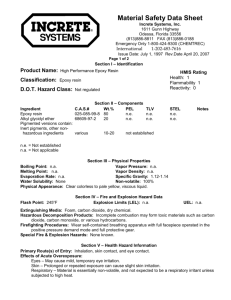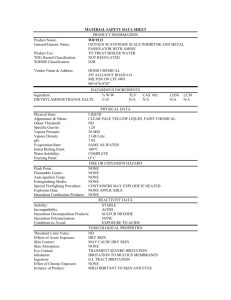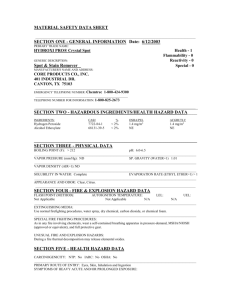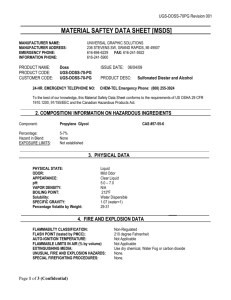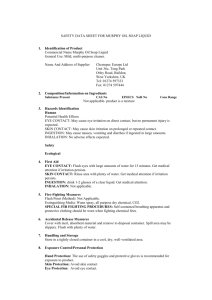SAFETY DATA SHEET
advertisement
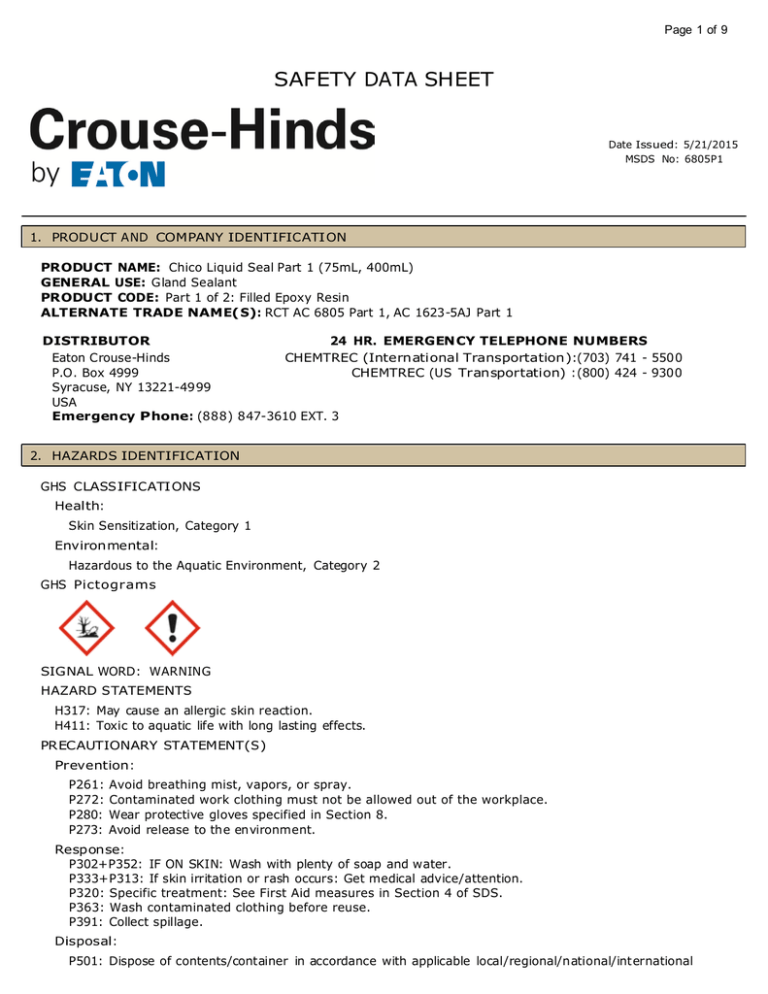
Page 1 of 9 SAFETY DATA SHEET Date Issued: 5/21/2015 MSDS No: 6805P1 1. PRODUCT AND COMPANY IDENTIFICATION PRODUCT NAME: Chico Liquid Seal Part 1 (75mL, 400mL) GENERAL USE: Gland Sealant PRODUCT CODE: Part 1 of 2: Filled Epoxy Resin ALTERNATE TRADE NAME(S): RCT AC 6805 Part 1, AC 1623-5AJ Part 1 DISTRIBUTOR 24 HR. EMERGENCY TELEPHONE NUMBERS Eaton Crouse-Hinds CHEMTREC (International Transportation):(703) 741 - 5500 P.O. Box 4999 CHEMTREC (US Transportation) :(800) 424 - 9300 Syracuse, NY 13221-4999 USA Emergency Phone: (888) 847-3610 EXT. 3 2. HAZARDS IDENTIFICATION GHS CLASSIFICATIONS Health: Skin Sensitization, Category 1 Environmental: Hazardous to the Aquatic Environment, Category 2 GHS Pictograms SIGNAL WORD: WARNING HAZARD STATEMENTS H317: May cause an allergic skin reaction. H411: Toxic to aquatic life with long lasting effects. PRECAUTIONARY STATEMENT(S) Prevention: P261: P272: P280: P273: Avoid breathing mist, vapors, or spray. Contaminated work clothing must not be allowed out of the workplace. Wear protective gloves specified in Section 8. Avoid release to the environment. Response: P302+P352: IF ON SKIN: Wash with plenty of soap and water. P333+P313: If skin irritation or rash occurs: Get medical advice/attention. P320: Specific treatment: See First Aid measures in Section 4 of SDS. P363: Wash contaminated clothing before reuse. P391: Collect spillage. Disposal: P501: Dispose of contents/container in accordance with applicable local/regional/national/international Page 2 of 9 SAFETY DATA SHEET Date Issued: 5/21/2015 MSDS No: 6805P1 regulations. EMERGENCY OVERVIEW PHYSICAL APPEARANCE: Liquid IMMEDIATE CONCERNS: May be slightly toxic and may be harmful if swallowed. May cause skin sensitization. May possibly cause pulmonary sensitization. May be irritating to the eyes and skin. POTENTIAL HEALTH EFFECTS EYES: Contact may cause eye irritation. SKIN: Irritating to skin. May cause sensitization by skin contact. SKIN ABSORPTION: Not Available INGESTION: May be slightly toxic and may be harmful if swallowed. INHALATION: Slightly irritating to the respiratory system. REPRODUCTIVE TOXICITY REPRODUCTIVE EFFECTS: None known. TERATOGENIC EFFECTS: None known. CARCINOGENICITY: This product or one of its ingredients present at 0.1% or more is NOT listed as a carcinogen or suspected carcinogen by NTP, IARC or OSHA. MUTAGENICITY: None known. MEDICAL CONDITIONS AGGRAVATED: Pre-existing skin disorders may be aggravated by over-exposure to this product. 3. COMPOSITION / INFORMATION ON INGREDIENTS Chemical Name Wt.% Epoxy Resin (1) 50 - 75 Trade Secret Epoxy Resin (2) Glass Fibers CAS 5 - 15 Trade Secret 15 - 30 65997-17-3 4. FIRST AID MEASURES EYES: Immediately flush eyes with plenty of water. Get medical attention, if irritation persists. SKIN: Wash with soap and water. Get medical attention if irritation develops or persists. INGESTION: Get immediate medical attention. Do not induce vomiting unless instructed to do so by poison center or physician. INHALATION: Move exposed person to fresh air. Keep person warm and at rest. If breathing is irregular or if respiratory arrest occurs, provide artificial respiration or oxygen by trained personnel. Get medical attention if adverse health effects persist or are severe. SIGNS AND SYMPTOMS OF OVEREXPOSURE EYES: Adverse symptoms may include the following: pain or irritation, watering, redness. SKIN: Adverse symptoms may include the following: irritation, redness SKIN ABSORPTION: None known. INGESTION: No specific data. Page 3 of 9 SAFETY DATA SHEET Date Issued: 5/21/2015 MSDS No: 6805P1 INHALATION: Adverse symptoms may include the following: respiratory tract irritation, coughing. CHRONIC EFFECTS: No known significant effects or critical hazards. 5. FIRE FIGHTING MEASURES EXTINGUISHING MEDIA: Use alcohol foam, carbon dioxide, or water spray when fighting fires involving this material. HAZARDOUS COMBUSTION PRODUCTS: Decomposition products may include the following materials: Carbon oxides EXPLO SION HAZARDS: In a fire or if heated, a pressure increase will occur and the container may burst. FIRE FIGHTING PROCEDURES: Promptly isolate the scene by removing all persons from the vicinity of the incident if there is a fire. FIRE FIGHTING EQUIPMENT: Fire-fighters should wear appropriate protective equipment and self-contained breathing apparatus (SCBA) with a full face-piece operated in positive pressure mode. SENSITIVE TO STATIC DISCHARGE: None known. SENSITIVITY TO IMPACT: None known. 6. ACCIDENTAL RELEASE MEASURES SMALL SPILL: Stop leak if without risk. Move containers from spill area. Vacuum or sweep up material and place in a designated, labelled waste container. Dispose of via a licensed waste disposal contractor. ENVIRONMENTAL PRECAUTIONS WATER SPILL: Avoid dispersal of spilled material and runoff and contact with soil, waterways, drains and sewers. Inform relevant authorities if the product has caused environmental pollution (sewers, waterways, soil or air). GENERAL PROCEDURES: Contain spilled material if possible. Absorb with materials such as: Sand. Collect in suitable and properly labeled containers. Remove residual with soap and hot water. Residual can be removed with solvent. Solvents are not recommended for clean-up unless the recommended exposure guidelines and safe handling practices for the specific solvent are followed. 7. HANDLING AND STORAGE HANDLING: Put on appropriate personal protective equipment. Eating, drinking and smoking should be prohibited where this material is handled, stored and processed. Workers should wash hands and face before eating, drinking and smoking. Do not get in eyes or on skin or clothing. Do not ingest. Use only with adequate ventilation. Empty containers retain product residue and can be hazardous. Do not reuse container. Refer to Section 8 for additional information. STORAGE: Store in accordance with local regulations. Store in original container protected from direct sunlight in a dry, cool and well-ventilated area. Keep container tightly closed and sealed until ready for use. Page 4 of 9 SAFETY DATA SHEET Date Issued: 5/21/2015 MSDS No: 6805P1 8. EXPOSURE CONTROLS / PERSONAL PROTECTION EXPOSURE GUIDELINES OSHA HAZARDOUS COMPONENTS (29 CFR1910.1200) EXPOSURE LIMITS OSHA PEL Chemical Name ppm ACGIH TLV mg/m3 ppm mg/m 3 Epoxy Resin (1) TWA Not Established Not Not Established Established Not Established Epoxy Resin (2) TWA Not Established Not Not Established Established Not Established Glass Fibers TWA Not Established [1] 5 [1] 5 [2] Not Established [2] Footnotes: 1. fibers, total dust [15 mg/m3] 2. Inhalable ENGINEERING CONTROLS: Use only with adequate ventilation. If user operations generate dust, fumes, gas, vapors or mist, use process enclosures, local exhaust ventilation or other engineering controls to keep workers exposure to airborne contaminants below any recommended or statutory limits. PERSONAL PROTECTIVE EQUIPMENT EYES AND FACE: Safety eyewear complying with an approved standard should be used when a risk assessment indicates this is necessary to avoid exposure to liquid splashes, mists, gases or dusts. SKIN: Use gloves chemically resistant to this material. Examples of preferred glove barrier materials include: Butyl rubber. Ethyl vinyl alcohol laminate ("EVAL"). Neoprene. Nitrile/Butadiene rubber ("nitrile" or "NBR"). Polyvinyl chloride ("PVC" or "vinyl"). NOTICE: The selection of a specific glove for a particular application and duration of use in a workplace should also take into account all relevant workplace factors such as, but not limited to: Other chemicals which may be handled, physical requirements (cut/puncture protection, dexterity, thermal protection), potential body reactions to glove materials, as well as the instructions/specifications provided by the glove supplier. RESPIRATORY: Respiratory protection should be worn when there is a potential to exceed the exposure limit requirements or guidelines. If there are no applicable exposure limit requirements or guidelines, wear respiratory protection when adverse effects, such as respiratory irritation or discomfort have been experienced, or where indicated by your risk assessment process. For most conditions, no respiratory prot ection should be needed; however, if handling at elevated temperatures without sufficient ventilation, use an approved air-purifying respirator. The following should be effective types of air-purifying respirators: Organic vapor cartridge. When grinding or sanding without sufficient ventilation of the cured product, use an approved dust mask. WORK HYGIENIC PRACTICES: Wash hands, forearms and face thoroughly after handling chemical products, before eating, smoking and using the lavatory and at the end of the working period. Appropriate techniques should be used to remove potentially contaminated clothing. Ensure that eyewash stations and safety showers are close to the workstation. Page 5 of 9 SAFETY DATA SHEET Date Issued: 5/21/2015 MSDS No: 6805P1 9. PHYSICAL AND CHEMICAL PROPERTIES PHYSICAL STATE: Liquid ODOR: Not Available ODOR THRESHOLD: Not Available APPEARANCE: Liquid COLOR: Red pH: Not Available PERCENT VOLATILE: NA = Not Applicable FLASH POINT AND METHOD: > 93°C (200°F) Setaflash FLAMMABLE LIMITS: Not Available AUTOIGNITION TEMPERATURE: Not Determined VAPOR PRESSURE: Negligible VAPOR DENSITY: > 1 BOILING POINT: Not Available SOLUBILITY IN WATER: Negligible EVAPORATION RATE: Not Available SPECIFIC GRAVITY: ~ 1.45 COEFF. OIL/WATER: Not Available 10. STABILITY AND REACTIVITY STABLE: Yes HAZARDOUS POLYMERIZATION: No STABILITY: This product is stable. Under normal conditions of storage and use, hazardous polymerization will not occur. POLYMERIZATION: Product will not undergo hazardous polymerization. CONDITIONS TO AVOID: Oxidizing materials. POSSIBILITY OF HAZARDOUS REACTIONS: Reacts with considerable heat release with some curing agents. HAZARDOUS DECOMPOSITION PRODUCTS: Carbon monoxide, aldehydes, and acids. INCOMPATIBLE MATERIALS: Reactive or incompatible with the following materials: oxidizing materials, strong acids, strong alkalis. Page 6 of 9 SAFETY DATA SHEET Date Issued: 5/21/2015 MSDS No: 6805P1 11. TOXICOLOGICAL INFORMATION ACUTE ORAL LD50 (rat) DERMAL LD50 (rabbit) INHALATION LC 50 (rat) Epoxy Resin (1) > 2000 mg/kg RAT > 2000 mg/Kg Rabbit No Data Available. Epoxy Resin (2) 4500 mg/kg RAT > 2000 mg/Kg RAT No Data Available. No Data Available No Data Available. Chemical Name Glass Fibers No data Available EYE EFFECTS: May cause slight eye irritation. Corneal injury is unlikely. SKIN EFFECTS: Prolonged contact may cause slight skin irritation with local redness. Repeated contact may cause moderate skin irritation with local redness. May cause more severe response if skin is abraded (scratched or cut). CHRONIC: Not Available SUBCHRONIC: Not Available CARCINOGENICITY IARC: Not classified NTP: Not classified OSHA: Not classified REPEATED DOSE EFFECTS: Not Available IRRITATION: Not Available CORROSIVITY: Not Available SENSITIZATION: Not Available NEUROTOXICITY: Not Available GENETIC EFFECTS: Not Available REPRODUCTIVE EFFECTS: Not Available TARGET ORGANS: Not Available TERATOGENIC EFFECTS: Not Available MUTAGENICITY: Not Available SYNERGISTIC MATERIALS: Not Available Page 7 of 9 SAFETY DATA SHEET Date Issued: 5/21/2015 MSDS No: 6805P1 12. ECOLOGICAL INFORMATION ENVIRONMENTAL DATA: Not Available ECOTOXICOLOGI CAL INFORMATION: Material is moderately toxic to fish on an acute basis (LC50 between 1 and 10 mg/l). BIOACCUMULATION/ACCUMULATION: Based on information for a similar material: Bioconcentration potential is moderate (BCF between 100 and 3000 or Log Pow between 3 and 5). DISTRIBUTION: Not Available AQUATIC TOXICITY (ACUTE) 96-HOUR LC 50 : 5.7 [mg/l] Species: Golden orfe (Leuciscus idus) 48-HOUR EC50 : 3.5 [mg/L]; 48 hr; water flea Daphnia magna CHEMICAL FATE INFORMATION: For similar material(s): Based on stringent OECD test guidelines, this material cannot be considered as readily biodegradable; however, these results do not necessarily mean that the material is not biodegradable under environmental conditions. 13. DISPOSAL CONSIDERATIONS DISPOSAL METHOD: The generation of waste should be avoided or minimized wherever possible. Dispose of surplus and non-recyclable products via a licensed waste disposal contractor. Disposal of this product, solutions and any by-products should at all times comply with the requirements of environmental protection and waste disposal legislation and any regional local authority requirements. Avoid dispersal of spilled material and runoff and contact with soil, waterways, drains and sewers. RCRA/EPA WASTE INFORMATION: If this material becomes a waste, it would not be a hazardous waste by RCRA criteria (40 CFR 261). 14. TRANSPORT INFORMATION DOT (DEPARTMENT OF TRANSPORTATION) PROPER SHIPPIN G NAME: Not regulated ROAD AND RAIL (ADR/RID) PROPER SHIPPIN G NAME: Environmentally Hazardous Substance, Liquid, N.O.S. (Epoxy Resin) UN NUMBER: 3082 HAZARD CLASS: 9 PA CKING GROUP: III AIR (ICAO/IATA) SHIPPING NAME: Environmentally hazardous substance, Liquid, N.O.S. TECHNICA L NAME: Epoxy Resin UN/NA NUMBER: 3082 PRIMARY HAZARD CLASS/DIVISION: 9 PA CKING GROUP: III VESSEL (IMO/IMDG) SHIPPING NAME: Environmentally hazardous substance, Liquid, N.O.S. TECHNICA L NAME: Epoxy Resin Page 8 of 9 SAFETY DATA SHEET Date Issued: 5/21/2015 MSDS No: 6805P1 UN/NA NUMBER: 3082 PRIMARY HAZARD CLASS/DIVISION: 9 PA CKING GROUP: III MARINE POLLUTANT #1: Yes 15. REGULATORY INFORMATION UNITED STATES SARA TITLE III (SUPERFUND AMENDMENTS AND REAUTHORIZATION ACT) 311/312 HAZARD CATEGORIES: Immediate (acute) and delayed health hazards FIRE: No PRESSURE GENERATING: No REACTIVITY: No ACUTE: Yes 313 REPORTABLE INGREDIENTS: None EPA EPA RQ INGREDIENT: None Expected. TSCA (TOXIC SUBSTANCE CONTROL ACT) TSCA REGULATORY: All ingredients in this material are on the TSCA Inventory. CALIFORNIA PROPOSITION 65: No California Proposition 65 listed chemicals are known to be present. CANADA WHMIS HAZARD SYMBOL AND CLASSIFICATION Toxic WHMIS (WORKPLACE HAZARDOUS MATERIALS INFORMATION SYSTEM): This product has been classified in accordance with the hazard criteria of the Controlled Products Regulations and the MSDS contains all of the information required by the Controlled Products Regulations. WHMIS CLASS: Class D-2B: Material causing other toxic effects (Toxic). DOMESTIC SUBSTANCE LIST (INVENTORY): The ingredients of this product are listed on the Domestic Substance List, Non-Domestic Substance List or are exempt. Page 9 of 9 SAFETY DATA SHEET Date Issued: 5/21/2015 MSDS No: 6805P1 16. OTHER INFORMATION APPROVED BY: MSDS Department PREPARED BY: MSDS Department HMIS RATING HEALTH 2 FLAMMABILITY 1 PHYSICAL HAZARD 0 PERSONAL PROTECTION MANUFACTURER SUPPLEMENTAL NOTES: Information Phone Number: (518) 399-5338 MANUFACTURER DISCLAIMER: The information in this SAFETY DATA SHEET should be provided to all who will use, handle, store, transport, or otherwise be exposed to this material. This information has been prepared for the guidance of plant engineering, operations, and management, and for persons working with or handling this material. Eaton Crouse-Hinds believes this information to be reliable and up-to-date as of the date of publication, but makes no warranty that it is.
